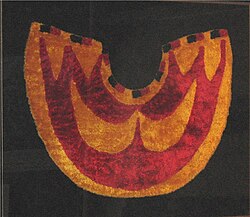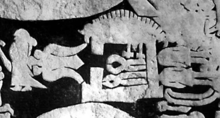


Feather cloaks have been used by several cultures.



Feather cloaks have been used by several cultures.
Elaborate feather cloaks called ʻahu ʻula[1] were created by early Hawaiians for the aliʻi (royalty).[2] Feathers were also used in women's skirts called pāʻū.[3] The ʻiʻiwi (Vestiaria coccinea) and ʻapapane (Himatione sanguinea), which provided red feathers, were killed and skinned due to their abundance. Yellow feathers were obtained from the mostly black and rarer ʻōʻō (Moho nobilis) and mamo (Drepanis pacifica) using a catch and release philosophy to ensure future availability.[4]
Famous works include:
|
Main article: Tupinambà cape |
Feather cloaks were known to the coastal Tupi people, notably the Tupinambá. The cloaks called gûaraabuku were dressed by the paîé (Tupian shamans) during rituals. They were made from the red plumage of gûará (Eudocimus ruber) and had a hood at the top, which could cover the entire head, shoulders and thighs up to the buttocks.
In Māori culture feathers are a sign of chiefly rank,[7] and the kahu huruhuru (feather cloak),[8] is still used as sign of rank or respect.[9][10]
Bird-hamir or feather cloaks that enable the wearers to take the form of, or become, birds are widespread in Germanic mythology and legend. The term hamir can be translated as various terms such as skin, cloak, costume, coat or form.[11][12][13][14][15]

In Norse mythology, goddesses Freyja and Frigg each own a feather cloak or feather costume that imparts the ability of flight.[15][16] Freyja is not attested as using the cloak herself,[17] however she lent her fjaðrhamr "feather cloak" to Loki so he could fly to Jötunheimr after Þórr's hammer went missing in Þrymskviða, and to rescue Iðunn from the jötunn Þjazi in Skáldskaparmál who had abducted the goddess while in an arnarhamr "eagle shape".[12][18][22] Loki also uses Frigg's feather cloak to journey to Geirröðargarða, referred to here as a valshamr ("falcon-feathered cloak").[25]
In Ynglinga saga, Óðinn is described as being able to change his shape into that of animals.[26] In the story of the Mead of Poetry from Skáldskaparmál, he does not explicitly require a physical item to assume an "eagle-form" (arnarhamr) to flee with the mead, in contrast to the jötunn Suttung, who must put on his (arnarhamr) in order to pursue him.[27][28]

In Völsunga saga, the wife of King Rerir is unable to conceive a child and so the couple prays to Odin and Frigg for help. Hearing this, Frigg then sends one of her maids wearing a krákuhamr (crow-cloak) to the king with a magic apple that, when eaten, made the queen pregnant with her son Völsung.[29][30][31]
The master smith Wayland forges a pair of wings to help his escape from King Niðhad after he is hamstrung, as depicted on a panel of the 8th-century whale-bone Franks Casket and described in the corresponding episode preserved in the Þiðreks saga.[32] Though the flying apparatus is called "wings" or "a wing" (Old Norse: flygil), borrowed from the German Flügel,[33] the finished product is said to be very much like a fjaðrhamr flayed from a griffin, or vulture, or an ostrich.[a][b][c][34][35][37]
Furthermore, the three swan-maidens, also described as valkyrjur, in the prose prologue of Völundarkviða own álftarhamir ("swan cloaks" or "swan garments") which give the wearer the form of a swan.[38][39][40] This bears similarity to the account of the eight valkyrjur with hamir in Helreið Brynhildar.[41][38]
There are also several attested uses of the term fjaðrhamr found in foreign material translated into Old Norse.[42][43] One example is Breta sögur, an Old Norse adaptation of Geoffrey of Monmouth's Historia Regum Britanniae that describes a pseudo-history of the Celtic Britons. In this account, the king Bladud uses a fjaðrhamr to fly;[44][14][43] while here fjaðrhamr does describe a flying suit, its usage does not involve transformation into bird.[14] In the original source, Bladud's flying contraption is described as a set of artificial wings he orders to be made.[14] The Middle English rendition, Layamon's Brut, also refers to Bladud's wings as Middle English: feðer-home, cognate with Old Norse: fjaðrhamr.[45]
There are bird-people depicted on the Oseberg tapestry fragments, which may be some personage or deity wearing winged cloaks, but it is difficult to identify the figures or even ascertain gender.[46]
In Ireland, the elite class of poets known as the filid wore a feathered cloak, the tuigen (see Suibhne Gelt).
In the Konungs skuggsjá, we can read a description of these poets in the chapter dealing with Irish marvels (XI):
There is still another matter, that about the men who are called “gelts,” which must seem wonderful. Men appear to become gelts in this way: when hostile forces meet and are drawn up in two lines and both set up a terrifying battle-cry, it happens that timid and youthful men who have never been in the host before are sometimes seized with such fear and terror that they lose their wits and run away from the rest into the forest, where they seek food like beasts and shun the meeting of men like wild animals. It is also told that if these people live in the woods for twenty winters in this way, feathers will grow upon their bodies as on birds; these serve to protect them from frost and cold, but they have no large feathers to use in flight as birds have. But so great is their fleetness said to be that it is not possible for other men or even for greyhounds to come near them; for those men can dash up into a tree almost as swiftly as apes or squirrels.[47]
The tuigen is also described in Sanas Cormaic and in the Immacallam in dá Thuarad.
This concept is adapted to the Greek mythology ; Mercury, god of medicine, wears a "bird covering" or "feather mantle" rather than talaria (usually conceived of as feathered slippers) in medieval Irish versions of the Greco-Roman classics, such as the Aeneid.[48]